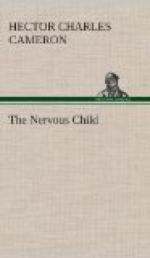In children beyond earliest infancy we recognise a gradual approach to the conditions of adult life. Fractiousness and naughtiness, ungovernable fits of temper, inconsolable weeping and inexplicable fears should disappear with early childhood even if management has not been perfect. If they persist to older childhood we shall find in an increasing percentage of cases evidence of definite neuropathic tendencies which urgently call for investigation and for a precise appreciation of the nature of the abnormality. It may be that the only effective treatment is that which we recognise as essential in the grosser mental disturbances—removal from the surroundings in which the abnormal conduct has had free play, and separation from the relatives whose anxiety and alarm cannot be hidden.
In young nervous children fear is the most prominent psychical symptom. The children are afraid of everything strange with which they come in contact. They are afraid of animals, of a strange face, or an unfamiliar room. Older children usually manage to control themselves, suppress their tears, and prevent themselves from crying out, but it is nevertheless easy to detect the struggle.
Often we find those distressing attacks to which the name “night-terrors” has been given. The child wakes with a cry,—usually soon after he has gone to sleep,—sits up in bed and shows signs of extreme terror, gazing at some object of his dreams with wide-open startled eyes, begging his nurse or mother to keep off the black dog, or the man, or whatever the vision may be. Even after the light is turned up and the child has been comforted, the terror continues, and half an hour may elapse before he becomes quiet and can be persuaded to go back to bed. In the morning as a rule he remembers nothing at all.
Phobias of all sorts are common in nervous children, and result from a morbid exaggeration of the instinct for self-preservation. Some cannot bear to look from a height, others grow confused and frightened in a crowd; dread of travelling, of being in an enclosed space such as a church or a schoolroom, or of handling sharp objects may develop into a constant obsession. I have known a little girl who was seized with violent fear whenever her father or mother was absent from the house, and she would stand for hours at the window in an agony of terror lest some harm should have befallen them. As if with some strange notion of propitiating the powers of darkness these children will often constantly perform some action and will refuse to be happy until they have done so. The same little girl who suffered such torments of anxiety in her parents’ absence would always refuse to go to bed unless she had stood in turn on all the doormats on the staircase of her home. Other children feel themselves forced to utter certain words or to go through certain rhythmical movements. They fully understand that the fear in their mind is irrational and devoid of foundation,




